Scientists have discovered that the brain may have a built-in way to fight Alzheimer's.
By activating a protein called Sox9, researchers were able to switch on star-shaped brain cells known as astrocytes and turn them into powerful cleaners that remove toxic plaques linked to memory loss. Tests in mice that already had Alzheimer's-like symptoms showed that boosting this protein helped clear out these harmful deposits and protect their memory.
Astrocytes and a Surprising Plaque-Clearing Mechanism
Researchers at Baylor College of Medicine have identified a natural process in the brain that can remove existing amyloid plaques in mouse models of Alzheimer's disease and help maintain memory and thinking ability. This process relies on astrocytes, star-shaped brain cells that can clear away the toxic plaques commonly found in Alzheimer's. When the researchers increased production of Sox9, a protein that guides many astrocyte functions as the brain ages, these cells became more effective at eliminating amyloid buildup. The findings, published today (November 21) in Nature Neuroscience, point to the possibility of developing treatments that strengthen astrocyte activity to slow cognitive decline in neurodegenerative conditions.
"Astrocytes perform diverse tasks that are essential for normal brain function, including facilitating brain communications and memory storage. As the brain ages, astrocytes show profound functional alterations; however, the role these alterations play in aging and neurodegeneration is not yet understood," said first author Dr. Dong-Joo Choi, who was at the Center for Cell and Gene Therapy and the Department of Neurosurgery at Baylor while he was working on this project. Choi currently is an assistant professor at the Center for Neuroimmunology and Glial Biology, Institute of Molecular Medicine at the University of Texas Health Science Center at Houston.
Decoding How Aging Astrocytes Change
In this study, the team set out to uncover how aging affects astrocytes and how those changes relate to Alzheimer's disease. They focused on Sox9 because it acts as a key regulator for many genes in aging astrocytes.
"We manipulated the expression of the Sox9 gene to assess its role in maintaining astrocyte function in the aging brain and in Alzheimer's disease models," said corresponding author Dr. Benjamin Deneen, professor and Dr. Russell J. and Marian K. Blattner Chair in the Department of Neurosurgery, director of the Center for Cancer Neuroscience, a member of the Dan L Duncan Comprehensive Cancer Center at Baylor and a principal investigator at the Jan and Dan Duncan Neurological Research Institute at Texas Children's Hospital.
Testing Sox9 in Mice With Existing Cognitive Decline
"An important point of our experimental design is that we worked with mouse models of Alzheimer's disease that had already developed cognitive impairment, such as memory deficits, and had amyloid plaques in the brain," Choi said. "We believe these models are more relevant to what we see in many patients with Alzheimer's disease symptoms than other models in which these types of experiments are conducted before the plaques form."
In these Alzheimer's models, the researchers either increased or removed Sox9 and then monitored the cognitive abilities of individual mice for six months, tracking how well they recognized familiar objects or environments. When the study concluded, the team examined the animals' brains to evaluate the amount of plaque that had accumulated.
Boosting Sox9 Reverses Plaque Build-Up and Cognitive Loss
Compared to reducing Sox9 expression, increasing it had the opposite effect. Sox9 knockout accelerated plaque formation, reduced astrocyte complexity and decreased clearance of amyloid deposits. Overexpression reversed these trends, promoting plaque clearance, while increasing the cells' activity and complexity. Importantly, overexpression of Sox9 also preserved cognitive function in these mice, indicating that astrocytic clearance of plaques halts neurodegenerative-related cognitive decline.
"We found that increasing Sox9 expression triggered astrocytes to ingest more amyloid plaques, clearing them from the brain like a vacuum cleaner," Deneen said. "Most current treatments focus on neurons or try to prevent the formation of amyloid plaques. This study suggests that enhancing astrocytes' natural ability to clean up could be just as important."
A Path Toward Astrocyte-Powered Therapies
Choi, Deneen, and their colleagues caution that more research is needed to understand how Sox9 works in the human brain over time. But their work opens the door to therapies that could one day harness the power of astrocytes to fight neurodegenerative diseases.
Reference: "Astrocytic Sox9 overexpression in Alzheimer's disease mouse models promotes Aβ plaque phagocytosis and preserves cognitive function" 21 November 2025, Nature Neuroscience.
DOI: 10.1038/s41593-025-02115-w
A number of additional researchers at Baylor College of Medicine played key roles in this project, including Sanjana Murali, Wookbong Kwon, Junsung Woo, Eun-Ah Christine Song, Yeunjung Ko, Debo Sardar, Brittney Lozzi, Yi-Ting Cheng, Michael R. Williamson, Teng-Wei Huang, Kaitlyn Sanchez and Joanna Jankowsky.
Funding for the study came from several National Institutes of Health grants (R35-NS132230, R01-AG071687, R01-CA284455, K01-AG083128, R56-MH133822). The project also received support from the David and Eula Wintermann Foundation, the Eunice Kennedy Shriver National Institute of Child Health & Human Development of the National Institutes of Health under Award Number P50HD103555, and from shared resources provided by Houston Methodist and Baylor College of Medicine.
News
Scientists Find a Way to Help the Brain Clear Alzheimer’s Plaques Naturally
Scientists have discovered that the brain may have a built-in way to fight Alzheimer’s. By activating a protein called Sox9, researchers were able to switch on star-shaped brain cells known as astrocytes and turn them into [...]
Vision can be rebooted in adults with amblyopia, study suggests
Temporarily anesthetizing the retina briefly reverts the activity of the visual system to that observed in early development and enables growth of responses to the amblyopic eye, new research shows. In the common vision [...]
Ultrasound-activated Nanoparticles Kill Liver Cancer and Activate Immune System
A new ultrasound-guided nanotherapy wipes out liver tumors while training the immune system to keep them from coming back. The study, published in Nano Today, introduces a biodegradable nanoparticle system that combines sonodynamic therapy and cell [...]
Magnetic nanoparticles that successfully navigate complex blood vessels may be ready for clinical trials
Every year, 12 million people worldwide suffer a stroke; many die or are permanently impaired. Currently, drugs are administered to dissolve the thrombus that blocks the blood vessel. These drugs spread throughout the entire [...]
Reviving Exhausted T Cells Sparks Powerful Cancer Tumor Elimination
Scientists have discovered how tumors secretly drain the energy from T cells—the immune system’s main cancer fighters—and how blocking that process can bring them back to life. The team found that cancer cells use [...]
Very low LDL-cholesterol correlates to fewer heart problems after stroke
Brigham and Women's Hospital's TIMI Study Group reports that in patients with prior ischemic stroke, very low achieved LDL-cholesterol correlated with fewer major adverse cardiovascular events and fewer recurrent strokes, without an apparent increase [...]
“Great Unified Microscope” Reveals Hidden Micro and Nano Worlds Inside Living Cells
University of Tokyo researchers have created a powerful new microscope that captures both forward- and back-scattered light at once, letting scientists see everything from large cell structures to tiny nanoscale particles in a single shot. Researchers [...]
Breakthrough Alzheimer’s Drug Has a Hidden Problem
Researchers in Japan found that although the Alzheimer’s drug lecanemab successfully removes amyloid plaques from the brain, it does not restore the brain’s waste-clearing system within the first few months of treatment. The study suggests that [...]
Concerning New Research Reveals Colon Cancer Is Skyrocketing in Adults Under 50
Colorectal cancer is striking younger adults at alarming rates, driven by lifestyle and genetic factors. Colorectal cancer (CRC) develops when abnormal cells grow uncontrollably in the colon or rectum, forming tumors that can eventually [...]
Scientists Discover a Natural, Non-Addictive Way To Block Pain That Could Replace Opioids
Scientists have discovered that the body can naturally dull pain through its own localized “benzodiazepine-like” peptides. A groundbreaking study led by a University of Leeds scientist has unveiled new insights into how the body manages pain, [...]
GLP-1 Drugs Like Ozempic Work, but New Research Reveals a Major Catch
Three new Cochrane reviews find evidence that GLP-1 drugs lead to clinically meaningful weight loss, though industry-funded studies raise concerns. Three new reviews from Cochrane have found that GLP-1 medications can lead to significant [...]
How a Palm-Sized Laser Could Change Medicine and Manufacturing
Researchers have developed an innovative and versatile system designed for a new generation of short-pulse lasers. Lasers that produce extremely short bursts of light are known for their remarkable precision, making them indispensable tools [...]
New nanoparticles stimulate the immune system to attack ovarian tumors
Cancer immunotherapy, which uses drugs that stimulate the body’s immune cells to attack tumors, is a promising approach to treating many types of cancer. However, it doesn’t work well for some tumors, including ovarian [...]
New Drug Kills Cancer 20,000x More Effectively With No Detectable Side Effects
By restructuring a common chemotherapy drug, scientists increased its potency by 20,000 times. In a significant step forward for cancer therapy, researchers at Northwestern University have redesigned the molecular structure of a well-known chemotherapy drug, greatly [...]
Lipid nanoparticles discovered that can deliver mRNA directly into heart muscle cells
Cardiovascular disease continues to be the leading cause of death worldwide. But advances in heart-failure therapeutics have stalled, largely due to the difficulty of delivering treatments at the cellular level. Now, a UC Berkeley-led [...]
The basic mechanisms of visual attention emerged over 500 million years ago, study suggests
The brain does not need its sophisticated cortex to interpret the visual world. A new study published in PLOS Biology demonstrates that a much older structure, the superior colliculus, contains the necessary circuitry to perform the [...]




















